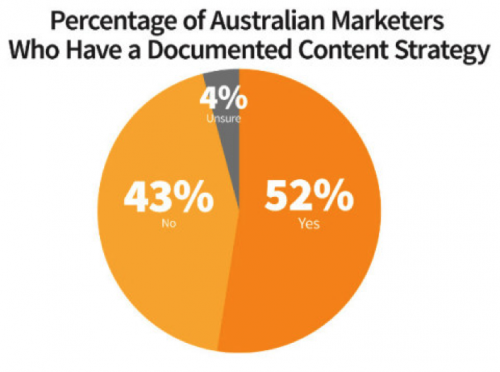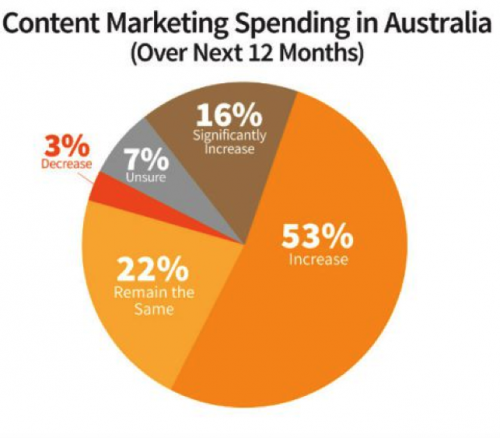Five years ago when I first started speaking about content marketing, no one knew what I was talking about. Even two years ago, I was still being asked to speak and present to audiences where content marketing was a new concept. In the past year, we’ve seen a massive shift in Australia. Content marketing is finally getting the attention it deserves as a plausible strategy for business. While this is extremely encouraging, we still have a long way to go before business starts to see the benefits associated with a content marketing initiative. So what’s holding us back?
Australia hooked on content marketing
According to recent research from the Content Marketing Institute, a staggering 93% of Australian marketers use content marketing. So that means pretty much everyone has accepted that content is the way to go. While that’s great news, the same research shows only 39% consider themselves effective at content marketing.
Identifying a big weakness
So what can be done to improve effectiveness? I believe the answer lies in another interesting statistic in the report. Only 52% of Australian marketers have a documented content strategy.
Three questions immediately come to mind for companies working without a strategy:
- How do you determine budget?
- What guides your execution?
- How can you measure effectiveness?
What worries me is that many of these companies without a content strategy will soon conclude content marketing just doesn’t work – or it doesn’t work for them. Another concern is many of the strategies I’ve seen aren’t really strategies but closer to a collection of unrelated tactics. It’s not unusual to discover a company with a content strategy that doesn’t address social media or search engine optimization (SEO). (Don’t get me started on why social media or SEO are not strategies – I’ll leave that for another post.)
What this means for business
Before you head down the content marketing path, I urge you to invest time and budget into developing a content strategy for your business. Not only will it provide a valuable roadmap for your content marketing, it will also give you the ability to measure effectiveness. I’m a firm believer high quality high-quality, original content is a long-term business asset, but only if it supports your objectives and goals.
And here’s one last thing to think about – 69% of Australian marketers plan to increase their content marketing spending in the next year. That’s even more reason to get a documented strategy in place.
If you’d like to know more about the value of a content marketing strategy, get in touch. I’d love nothing more than to have a chat to help you better understand what a content strategy entails.
- by Sarah Mitchell
Graphs courtesy of the Content Marketing Institute.
“Moving the queen” courtesy of Gabriel Saldana on Flickr.











I chuckled when entering my details in order to submit this comment when the ‘catchya’ required me to give the sum of 9 & 7. I wondered to myself whether the folk at Content Marketing Institute could have managed it - neither pie chart totals 100%.
On a less flippant note, there are still some copywriters (content writers) who are not wholly sold on content marketing. Bob Bly for one says he’s been writing this form of marketing material since the 1980s. He is also wary of those who seek to only inform and educate the prospect, while overlooking the need to achieve a sale. And he argues that the skills needed for the latter are more important and less easily acquired than the former.
See his blog: www.http://bly.com/blog/general/the-awful-truth-about-content-marketing/
Hi Nick,
You know you’ve tapped into a huge, raging debate almost as old as time, right? Bly is right, but he’s wrong, too.
I’ve held both marketing and sales roles. When I say sales, I mean selling with a big quota and earnings based largely on commission. And, as you can surmise, I’ve been working in the content marketing space for a long time, too. While sales can operate with marketing, there’s no point in marketing if you don’t plan to sell anything. So I agree with Bob, to an extent.
And, yes, content marketing is as old as the hills. I’m not sure I would trust anyone that inferred otherwise. But copywriting is not content marketing. Copywriting will get you great content but you also need distribution and ‘findability’.
When it works best, content marketing is generating plenty of leads and nurturing future leads. That’s not an easy task which is why you need a strong strategy.
Thanks so much for stopping in. It’s always great to have these debates. What’s your view of Bly’s comments about content marketing?
I wouldn’t suggest Bob Bly is of the old school of copywriters (he’s younger than me) but he is certainly an ardent admirer. He is a believer in adhering to those essentials that have been tried, tested and found to work.
He’s an admirer of David Ogilvy, whom I think he sees as a kindred spirit. You’ll know that Ogilvy foreswore creative advertising – he confessed to lacking creativity – and instead relied on hard work, extensive research, and then more hard work and research. We are all familiar with Ogilvy’s dictum that if advertising does not sell it is not creative. Bly admires Ogilvy’s structured formula – trained as a chemical engineer, I imagine he would – because such an approach to promotional writing lends itself to repetition and analysis.
That is where Bob Bly is coming from when he writes about content marketing. He is, I think, a natural sceptic and he is suspicious of those who seem to claim that it is an epiphany-making concept. His creed might well be that there’s nought new under the sun, and (I may exaggerate here) that content marketing is akin to alchemy.
I see the ingredients necessary for copy that will succeed as (amongst other things) (a) overcoming the prospect’s scepticism, (b) identifying a high-value feature in the product, (c) demonstrating the product works, and works well, and (d) inserting in the prospect’s mind the strongest belief in the benefits to be had by acquiring the product. These can all be achieved by evidential proof.
Such an approach does not require hype or over-playing the sales card. There can always be a place for opening the prospect’s eyes to new ideas about the product and revealing a new plain of understanding about its hidden treasures. But these seem to me to be nebulous, lightweight tools that lack mass, being more likely to stroke and titillate than to actually feed the mind with imaginings.
A final thought – without suggesting that content writing can mean all things to all men and women, it nevertheless seems difficult to define or pin down. And recent statistics indicate that prospective buyers are less influenced by the enlightenment that accompanies content marketing than they are by more formulaic copywriting that seeks to perceive and persuade.
Hi Nick,
You’re not wrong. I attended a webinar by Bob Bly when I first started in copywriting. I follow his blog. He’s incredibly successful. As you say, he follows a tried and true formula. If I were him, I’d be sceptical too and it would be hard for me to see why I should change my habits.
But Bly is not versatile and content marketing requires versatility. It’s not solely reliant on copywriting. As consumers and the viewing public move toward more visual content, so too, should marketers.
Content marketing is very much like publishing. The managing editor - or CCO - has to have content for every audience. Some of it is simply to entertain. Some of it is to draw attention to a specific topic. Some of it is meant to start debate. Some of it is meant to sway opinion. Some of it absolutely is meant to close business. You can’t always focus on entertainment and expect to succeed but neither can you bash your audience over the head with direct mail content and repeated calls to action.
No one piece of content will necessarily convert a reader. It’s a collective effort that helps a brand build authority, establish their expertise and gain influence. One thing the Content Marketing Institute is asking content marketers to do is figure out how many pieces of content - or touchpoints - it takes to convert someone in your target audience. There’s evidence to suggest the magic number might be four pieces as long as the content is ‘on message’ and you’re not unintentionally confusing the viewer.
And this is why it’s important to have a strategy. If you’re not producing a variety of content for different stages of your buying cycle and hitting your key audience, content marketing is a big waste of time and money. You need to be able to produce, measure and refine as you go. Bob Bly knows exactly how well every single direct mail campaign he produces performs. That’s why he’s one of the best. We all need to move to that mentality and do it across a variety of content. When we can do that, then we’re really ‘content marketing’.
Thanks so much for your thoughtful comments and insight. I’m fascinated with the topic, as you can tell.
[…] concept of upcycling in content marketing is one of the principle benefits of adopting a content marketing strategy. Content providers avoid a ‘one-stop shop’ mentality of creating a solo video or podcast. […]
[…] of the biggest success indicators for content marketing is having a documented content marketing strategy. In Australia, only 37% of all marketers say they have one. This means a whole lot of content is […]
[…] Content marketing must start with a document strategy to be effective. If you’re buying into content marketing without taking the time to develop a strategy, you’re […]
Is there any other data you can cite that isn’t from The CMI? I mean, really, it’s like cigarette companies citing their own research that smoking doesn’t kill.
Not doubting content marketing’s impact, would just like to see some independent analysis.
Hi Brent,
No one does more comprehensive research about content marketing than the Content Marketing Institute. They produce a number of reports focusing on specific segments and locales. Because they’ve been doing it longer than anyone else and they report on so many different angles (B2B, B2C, NFP, North America, Europe, Australia), they’re a valuable resource. Also, they make it incredibly easy to report on their findings because they don’t charge, gate nothing, and provide good images for journalists, brand journalists and bloggers to use. I think your cigarette company analogy is harsh and unfair.
You can find similar information from a number of different companies, including:
Aberdeen Group - The Future of Content Marketing: The Age of Content Science, October 2015 (registration required)
LinkedIn - B2B Content Marketing Report - October 2014
Altimeter - The Content Marketing Software Landscape: Marketer Needs & Vendor Solutions, May 2014